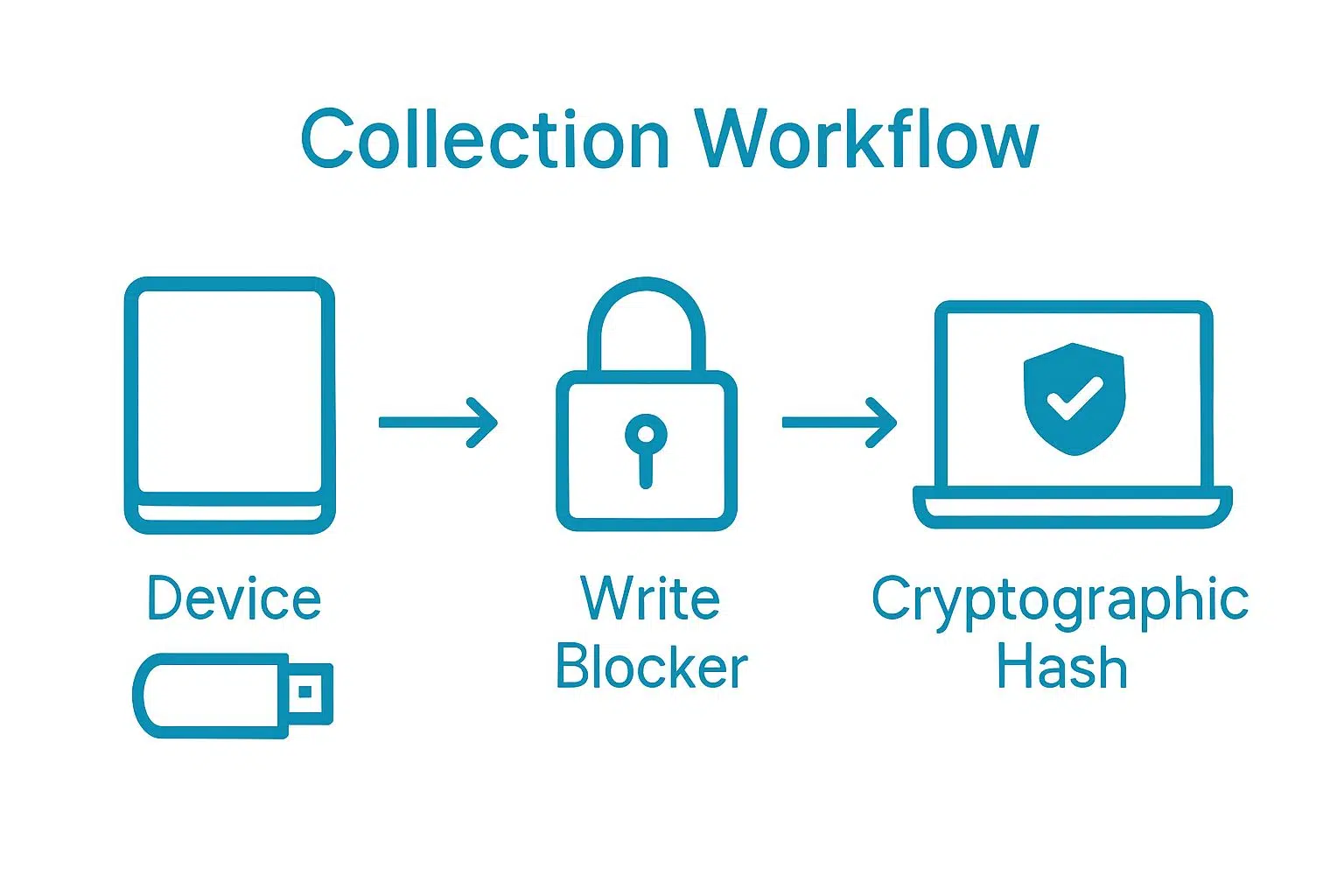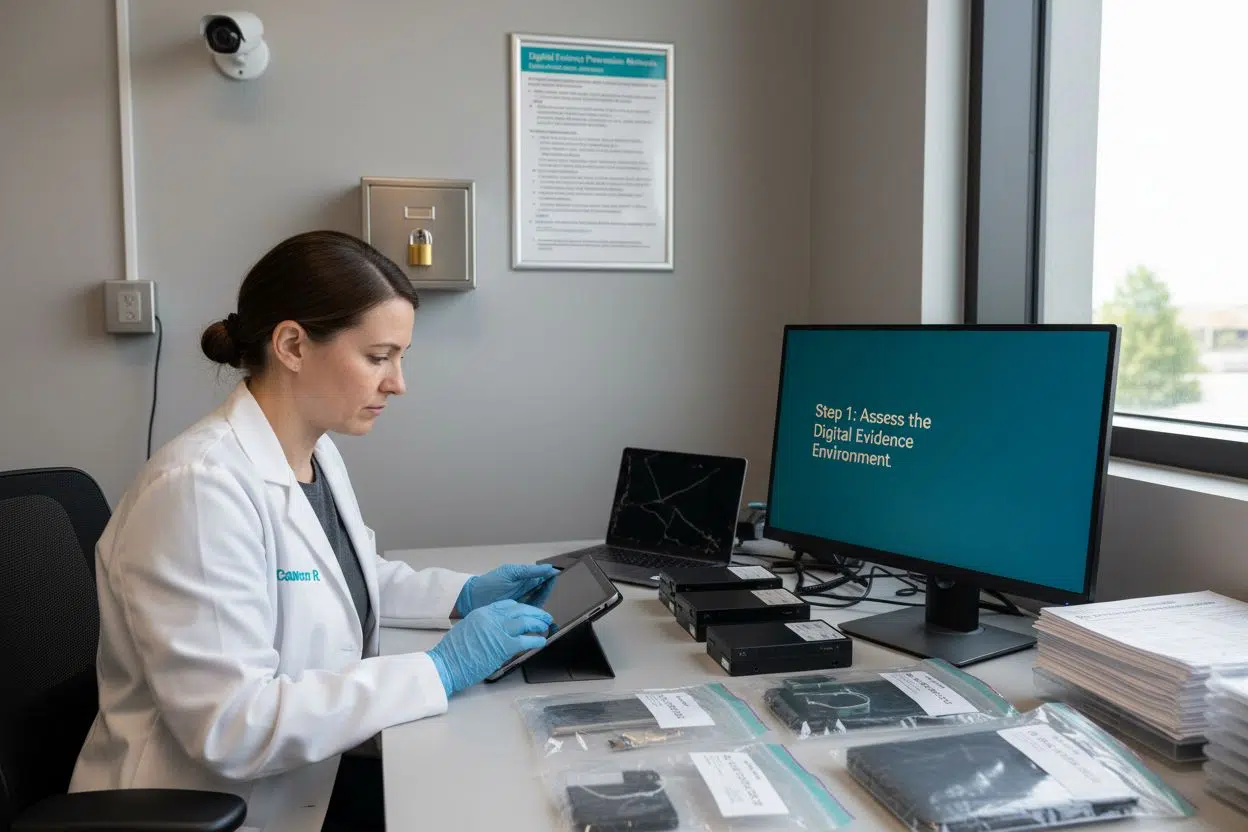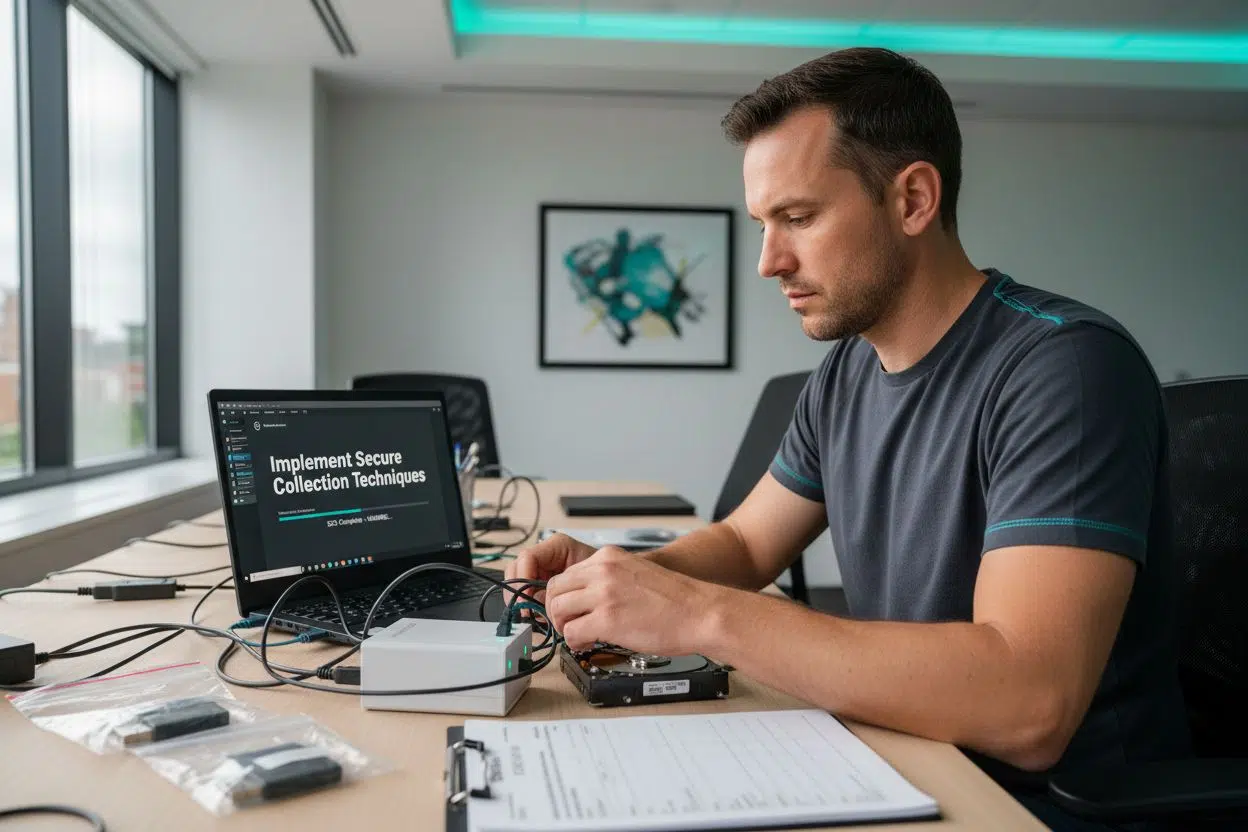Preserving digital evidence is becoming more complex every year. With critical data now scattered across everything from workplace servers to individual smartphones, the task seems straightforward on paper. Yet, over 80 percent of digital evidence mishandling issues arise not from collection mistakes, but from poorly managed assessment and documentation processes. Most surprising of all, it’s often the meticulous record-keeping and quiet background checks that make or break a case—not the high-tech tools everyone talks about.
Table of Contents
- Step 1: Assess The Digital Evidence Environment
- Step 2: Identify Relevant Digital Evidence Sources
- Step 3: Implement Secure Collection Techniques
- Step 4: Document Evidence Collection Procedures
- Step 5: Store Evidence In A Controlled Environment
- Step 6: Verify Integrity Of Preserved Digital Evidence
Quick Summary
| Key Point | Explanation |
|---|---|
| 1. Conduct a thorough digital asset inventory | Develop a detailed map of all digital systems and devices to identify potential evidence locations. |
| 2. Document chain of custody meticulously | Maintain strict logs of every action taken during evidence collection to ensure legal and forensic integrity. |
| 3. Use validated forensic tools for collection | Employ industry-standard tools for evidence extraction that prevent data alteration and maintain integrity. |
| 4. Implement secure and controlled storage | Store digital evidence in an environmentally controlled setting to protect it from contamination or unauthorized access. |
| 5. Verify evidence integrity with hash values | Generate cryptographic hashes to ensure digital evidence has not been altered and is reliable for legal proceedings. |
Step 1: Assess the Digital Evidence Environment
The initial phase of digital evidence preservation requires a comprehensive and systematic approach to understanding the specific digital environment where potential evidence resides. Successful assessment begins with creating a detailed map of all digital systems, devices, and potential data repositories that might contain critical information relevant to an investigation.
Identifying and cataloguing digital assets involves more than a cursory scan. Investigators must develop a meticulous strategy that captures the nuanced landscape of digital information storage. This means examining workstations, servers, mobile devices, cloud storage platforms, network drives, external hard drives, and backup systems with precision and thoroughness.
Professional forensic practitioners recommend starting with a comprehensive inventory that documents each digital asset’s location, current status, and potential vulnerability. You will need to understand the specific hardware configurations, operating systems, and network architectures that might impact evidence preservation. Learn more about advanced digital forensic techniques to enhance your investigative approach.
The assessment phase also demands careful consideration of potential data volatility. Different digital platforms have varying levels of data persistence and vulnerability to alteration. Some key considerations include:
- Determining the current operational status of each digital system
- Identifying potential risks of data modification or accidental deletion
- Evaluating network connectivity and potential remote access scenarios
- Assessing user access privileges and potential manipulation points
Professional investigators must approach this step with a forensically sound methodology that preserves the integrity and admissibility of potential digital evidence. This means documenting every action, maintaining strict chain of custody protocols, and using validated forensic tools that can capture data without altering the original digital environment.
Successful completion of the assessment phase means having a comprehensive, documented understanding of the digital landscape, with clear strategies for protecting and extracting potential evidence while maintaining its legal and technical reliability.
Below is a summary table outlining each critical step in the digital evidence preservation process, including a brief description and the main objective of each stage.
| Step | Description | Primary Objective |
|---|---|---|
| Assess Environment | Analyse and document all digital assets, systems, and vulnerabilities. | Create a comprehensive map for evidence protection. |
| Identify Sources | Locate all potential evidence repositories (devices, accounts, logs). | Ensure no relevant evidence is overlooked. |
| Secure Collection | Use validated tools and methods to extract data without alteration. | Maintain forensic soundness of collected evidence. |
| Document Procedures | Record every action, tool, and observation during the collection. | Provide a transparent, auditable record. |
| Controlled Storage | Store evidence in secure, environmentally protected conditions. | Prevent contamination, loss, or unauthorised access. |
| Verify Integrity | Use cryptographic hashes and other checks to confirm evidence has not changed. | Guarantee legal and technical reliability. |
Step 2: Identify Relevant Digital Evidence Sources
Identifying relevant digital evidence sources demands a strategic and comprehensive approach that goes beyond simple data collection. This critical step involves pinpointing precise locations where digital artifacts might provide crucial investigative insights. Investigators must develop a systematic method for recognising potential evidence repositories across multiple digital platforms and technological ecosystems.
The identification process requires understanding that digital evidence can exist in numerous formats and locations. Electronic devices are not the only sources of potential evidence. Network logs, cloud storage platforms, communication applications, social media accounts, and even seemingly peripheral digital systems can hold critical information. Investigators must adopt a holistic perspective that considers both direct and indirect digital evidence sources.
Professional digital forensic practitioners recommend creating a comprehensive mapping of potential evidence sources. This involves examining system logs, user activity records, communication platforms, backup systems, and interconnected network devices. Each potential source requires careful evaluation to determine its relevance and potential evidentiary value. Learn more about digital evidence collection techniques to refine your investigative approach.
The identification process also demands understanding the technical and legal parameters surrounding digital evidence collection. Different digital platforms have unique characteristics that impact evidence preservation. Some key considerations include:
- Assessing data accessibility and potential retrieval challenges
- Understanding jurisdiction-specific legal restrictions on evidence collection
- Evaluating the potential fragility or volatility of digital information
- Determining the potential authentication requirements for different evidence sources
Successful source identification requires meticulous documentation. Each potential evidence source must be carefully logged, with detailed information about its location, current status, and potential relevance to the investigation. Investigators should create a comprehensive inventory that allows for systematic tracking and subsequent forensic analysis.
Ultimately, the goal of this step is not just to identify sources, but to create a robust, defensible framework for digital evidence collection that maintains the integrity and admissibility of potential investigative materials.
Step 3: Implement Secure Collection Techniques
Implementing secure digital evidence collection techniques represents a critical junction where methodological precision meets legal and technological requirements. This step transforms the theoretical identification of evidence sources into a practical, forensically sound extraction process that maintains data integrity and legal admissibility.
Secure collection begins with understanding that every interaction with digital evidence carries the potential to alter or compromise its original state. Professional forensic practitioners must approach evidence extraction with an extremely delicate touch, using specialised write-blocking hardware and forensically validated software tools that prevent unintentional data modification during the collection process.
The collection strategy must account for the unique characteristics of different digital platforms. Investigators need to develop nuanced approaches that adapt to various technological environments, whether dealing with mobile devices, cloud storage systems, or complex networked infrastructures. Explore advanced digital forensic techniques to enhance your investigative methodology.
Critical considerations during secure collection include creating comprehensive forensic images that capture entire system states without altering underlying data.

Key operational protocols for secure evidence collection include:
- Maintaining strict chain of custody documentation
- Using validated forensic imaging tools with cryptographic hash verification
- Implementing multiple evidence preservation strategies
- Creating redundant forensic copies to mitigate potential data loss
Professional investigators must also address the challenges of collecting volatile digital evidence. Systems with active memory, running applications, and network connections require immediate and specialised collection techniques that capture ephemeral data before it can be lost or altered.
Successful implementation of secure collection techniques means producing forensically sound digital evidence that can withstand rigorous legal and technical scrutiny. This requires not just technical expertise, but a meticulous approach that treats each piece of digital information as a potential critical component of an investigative narrative.
Step 4: Document Evidence Collection Procedures
Documenting evidence collection procedures represents the critical forensic safeguard that transforms technical actions into legally defensible investigative records. This step goes far beyond simple note-taking, requiring a systematic and comprehensive approach that creates a transparent, verifiable narrative of every investigative action.
Professional digital forensic practitioners understand that documentation is not an administrative afterthought, but a fundamental component of forensic integrity. Each action, observation, and technical procedure must be meticulously recorded in a manner that allows independent verification and reconstruction of the entire evidence collection process.
The documentation process demands creating detailed logs that capture the precise circumstances of evidence acquisition. This includes recording specific hardware configurations, software versions, network states, and environmental conditions at the time of evidence collection. Learn more about digital forensics in litigation to understand the legal implications of thorough documentation.
Investigators must develop a standardised documentation framework that addresses multiple critical dimensions of evidence collection. This comprehensive approach involves capturing technical metadata, chronological sequences of actions, and detailed explanations of the methodological reasoning behind each investigative decision.
Key documentation requirements include:
- Generating cryptographic hash values for all collected digital evidence
- Recording precise timestamps with timezone information
- Documenting all personnel involved in the evidence collection process
- Capturing detailed system and network configuration screenshots
- Creating comprehensive chain of custody logs
Successful documentation serves multiple crucial functions beyond immediate investigative needs. It provides a robust audit trail that can withstand potential legal challenges, demonstrates the professionalism of the investigative team, and creates a replicable methodology for future forensic examinations.
The ultimate goal of this documentation process is to create a forensically sound narrative that bridges technical actions with legal requirements. Each documented detail becomes a potential critical piece of evidence, capable of withstanding rigorous scrutiny in legal proceedings. Investigators must approach documentation with the same precision and attention to detail they apply to technical evidence collection itself.
Step 5: Store Evidence in a Controlled Environment
Storing digital evidence requires an extremely sophisticated approach that goes far beyond simple physical preservation. This critical step demands creating a highly secure, environmentally controlled storage ecosystem that protects digital artifacts from potential contamination, degradation, or unauthorised access.
Digital evidence storage involves managing multiple complex variables that could potentially compromise investigative materials. Temperature, humidity, electromagnetic interference, and physical access represent significant risk factors that investigators must meticulously control. Professional forensic practitioners understand that digital storage media are exceptionally sensitive to environmental conditions, requiring specialised preservation strategies that maintain data integrity.
Learn more about comprehensive chain of custody procedures to enhance your evidence management protocols. The storage environment must provide robust protection against physical and digital threats, incorporating multiple layers of security that prevent accidental or intentional data manipulation.
Forensic-grade storage solutions require implementing multiple protective mechanisms. This includes using write-protected storage devices, maintaining controlled access through biometric or multi-factor authentication systems, and creating redundant backup systems that preserve evidence across different physical locations.
Key storage protocol considerations include:
- Maintaining consistent temperature and humidity levels
- Using electromagnetic shielded storage containers
- Creating encrypted, tamper-evident digital storage systems
- Implementing comprehensive access logging mechanisms
- Developing redundant backup strategies with geographically distributed storage
Investigators must also consider the long-term preservation requirements for different types of digital media. Hard drives, solid-state drives, optical media, and cloud-based storage each require unique preservation techniques that account for their specific technological characteristics.
Successful evidence storage means creating an unbroken chain of custody that provides complete traceability and accountability. Every storage interaction must be meticulously documented, with clear records of access, environmental conditions, and potential interactions. The goal is to maintain digital evidence in a state that is forensically sound, legally defensible, and scientifically verifiable throughout the entire investigative process.
Step 6: Verify Integrity of Preserved Digital Evidence
Verifying the integrity of preserved digital evidence represents the critical final checkpoint in ensuring the forensic reliability of investigative materials. This step transforms previous preservation efforts into a legally defensible and scientifically validated process that can withstand intense scrutiny in judicial proceedings.
Cryptographic hash verification stands as the primary method for confirming digital evidence integrity. Investigators must generate comprehensive hash values using multiple algorithmic approaches, such as MD5, SHA-1, and SHA-256, to create a robust digital fingerprint that can detect even the most minute alterations to the original evidence.
Explore advanced digital forensic techniques to enhance your evidence verification methodology. Professional forensic practitioners understand that integrity verification goes beyond simple checksum generation, requiring a multifaceted approach that examines technical, metadata, and contextual aspects of digital evidence.
The verification process demands a systematic examination of multiple forensic attributes, including file system metadata, timestamp consistency, and potential hidden modifications. Investigators must employ specialised forensic tools that can perform deep-level analysis, comparing current evidence states against original collection snapshots.
Key verification protocols include:
- Generating multiple cryptographic hash values
- Performing bit-by-bit comparisons of forensic images
- Validating metadata consistency across different forensic tools
- Checking for potential hidden file system alterations
- Documenting all verification processes and results
Successful integrity verification requires more than technical precision. Investigators must create comprehensive documentation that demonstrates a clear, unbroken chain of evidence handling. This involves generating detailed reports that explain the verification methodology, tools used, and specific techniques employed to confirm the evidence’s forensic integrity.
The ultimate goal of this verification step is to produce digital evidence that is scientifically reliable, legally admissible, and capable of withstanding rigorous technical and judicial examination. Each verification action becomes a critical component in building a defensible forensic narrative that can support investigative objectives across various legal and technical contexts.
The following table provides a checklist for verifying the integrity of preserved digital evidence, helping to ensure each requirement is systematically addressed and documented.
| Verification Requirement | How to Verify | Why It Matters |
|---|---|---|
| Generate cryptographic hash values | Use tools to create MD5, SHA-1, SHA-256 hashes | Detects any data alteration |
| Bit-by-bit comparison | Compare forensic images at binary level | Confirms exact replication |
| Validate metadata consistency | Cross-check timestamps, properties, system logs | Ensures contextual integrity |
| Examine for hidden alterations | Use forensic tools to scan for hidden files or changes | Identifies tampering or concealment |
| Document verification processes | Record methods, tools, and results in reports | Creates audit trail for legal scrutiny |
Preserve Evidence the Right Way: Secure Your Digital Case for 2025
Many organisations struggle with the pressure to ensure digital evidence stands up in court or internal investigations. The article you read highlights how easy it can be to lose vital data through accidental modification, poor chain of custody, or using the wrong collection methods. Your goals are clear: maintain absolute integrity, expertly document every step, and implement techniques that keep digital evidence legally admissible and technically reliable. But managing the complexity of systems, devices, and compliance requirements can quickly feel overwhelming.
This is where Computer Forensics Lab’s Digital Forensics solutions make the difference. Our forensic specialists employ the exact preservation methods discussed in this article, ensuring every asset is meticulously handled from assessment through to secure storage and verification. We help safeguard your evidence across computers, mobile devices, cloud sources, and more. Rely on our experience with digital forensic investigations to strengthen your legal position and secure expert witness support when it matters most. Do not risk the integrity of your case with incomplete or outdated methods. Visit https://computerforensicslab.co.uk now to book a confidential consultation and ensure your digital evidence is ready for 2025 and beyond.
Frequently Asked Questions
What are the essential methods for preserving digital evidence in 2025?
Successful digital evidence preservation involves assessing the digital environment, identifying relevant evidence sources, implementing secure collection techniques, documenting the evidence collection procedures, storing evidence in a controlled environment, and verifying the integrity of preserved digital evidence.
Why is it important to document evidence collection procedures?
Documenting evidence collection procedures is crucial for maintaining forensic integrity. It creates a transparent narrative of every investigative action, which can withstand legal scrutiny and provides a robust audit trail for future reference.
What are the best practices for securely collecting digital evidence?
Best practices for securely collecting digital evidence include using write-blocking hardware, generating comprehensive forensic images without altering the original data, maintaining chain of custody documentation, and implementing multiple preservation strategies to safeguard against data loss.
How can investigators verify the integrity of preserved digital evidence?
Investigators can verify the integrity of preserved digital evidence by generating cryptographic hash values, performing bit-by-bit comparisons of forensic images, and checking metadata consistency. This ensures that any alterations to the evidence can be detected, thus maintaining its reliability for legal proceedings.

